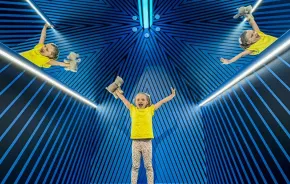
Bottom line
Professional and student dancers get a chance to shine in this silly story ballet with serious classical technique. Coppélia will be performed at Pacific Northwest Ballet through Sunday, April 24.
Stage notes
Although it is one of the first comedic story ballets, Coppélia is still considered one of the best. Using the classical choreography of Marius Petipa’s 1884 staging as a foundation, in 1974 George Balanchine reworked the ballet into the version performed today. The music and dancing are among the finest examples of classical ballet, while the story is the kind of sheer silly nonsense usually associated with Lewis Carroll. It’s not a Wonderland story, though — Coppélia first appeared as a story in E.T.A. Hoffmann’s Der Sandmann in 1815. (Another of Hoffmann’s stories was the basis for the beloved family ballet, The Nutcracker.) The story reads like a spoof of Pygmalion, and it’s goofy enough that many children will find it helpful to know what happens in advance; the story is summarized online.
Earlier this season, Pacific Northwest Ballet performed Romeo et Juliette, a dance that perfectly captured the depth of adolescent emotion. Coppélia captures another side of the adolescent experience – immaturity. My sixth grader was quick to note that the hero Franz was not a very nice person; he kills a butterfly, picks on an old man and is disloyal to his girlfriend.
For her part, the beautiful Swanilda leads a girl gang in breaking and entering the same old man’s house, where she pranks him and breaks all his toys. It’s gratifying when your middle schooler calls out such behavior, but in the context of the story, it’s not particularly significant. Everyone onstage is having a good time behaving badly (even the persecuted old man is far from innocent) and the real point of the story is the dance.
Balanchine managed to maintain the classical rigor of Petipa’s original ballet while infusing it with … well, fun.
Petipa ballets demand the highest level of technical skill, but aesthetically they can be too rigid, looking more like dance class drills than real choreography. Balanchine managed to maintain the classical rigor of Petipa’s original ballet while infusing it with … well, fun. Wry faces accompany the traditional movements, melodramatic hand-waving accompanies complicated pointe work and even complicated lifts are made to look playful.
There is typically one act in a story ballet where the story breaks down to “and then everyone takes turns showing off their dance moves.” In Coppélia that is Act Three, but young viewers might not notice the principals’ incredible technique. Their eyes will be glued to the corps de ballet, which has been replaced by students ages 10–13 from the Pacific Northwest Ballet School.
While it’s not uncommon for students to perform in professional productions, they usually do so in small numbers and extremely simple roles – essentially set dressing. In Coppélia they make up the corps de ballet for 20 minutes, supporting the professionals in four solos. It is a testament to the quality of the PNB School that these young dancers performed the unsimplified role of the corps with almost the same level of grace as their professional counterparts. At one point the applause continued for what was obviously longer than they had rehearsed. The young dancers hesitated, looking at each other and at the conductor, unsure how long to hold their pause. Aside from that moment’s uncertainty, the only reminder that these were not the regular corps de ballet might have been the huge smiles of children about to burst from excitement.
Parents should know
The most upsetting part of the ballet for many children will be Franz killing a butterfly and pinning it to his shirt. When the girls break into the old man’s workshop they are afraid, but there is nothing scary for the audience, and even sensitive children will laugh at the dancers’ fearful histrionics.
Parents may disapprove of the characters’ choices, but we can immediately recognize their immaturity, careless good humor and temperamental mood swings from our own middle schoolers. It may be worthwhile to talk about the characters’ moral failings with your kids, but it’s not critical — even children will have a hard time taking these characters very seriously. Afterwards, my sixth grader mostly wanted to talk about the exquisite costumes. My first grader was too busy practicing her chassés and jetées to talk.
If you go...
When and where: Thursday, April 21 – Saturday, April 23 at 7:30 p.m.; Sunday, April 24 at 1 p.m.
Marion Oliver McCaw Hall, 321 Mercer Street, Seattle, WA 98109. If you haven’t been to Seattle Center lately, please note that Mercer and Roy streets are now open to traffic in both directions.
Tickets: Tickets start at $30 and increase by performance and according to seating to $187. Every family member must have a ticket, even babes in arms. Tickets can purchased online.
Parking: The Mercer Street Garage is attached to McCaw Hall by a skybridge and costs $15-$20 depending on events at Seattle Center. Other parking options in the area have similar pricing.
Tips:
• Activities: In the hour preceding the matinee performance children can take part in a craft station, story time, mini dance class, and tutu show and tell. Crafts continue at intermission, other activities are pre-performance only.
• Booster seats are available near the coat check at no charge. Binoculars can be rented for a fee.
• There are several concession areas in McCaw Hall. It is best to preorder snacks for intermission, as the lines can be long. You may bring snacks from home to eat during intermission but no food is allowed in the auditorium.
• Coppélia is approximately 2 hours and 22 minutes including two intermissions and is age appropriate for any child who can sit quietly and pay attention for 40 minutes.











